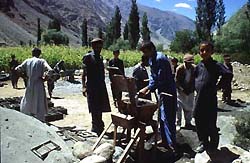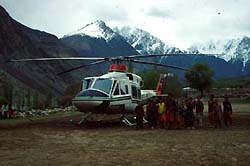| 3. Taking Advantage of Outside Help
However, this does not mean in any way that the activities of the Ismailis are exclusionary in nature. Rather, the Aga Khan Foundation deftly makes use of outside help by characterizing its activities as a “participatory approach” by local residents. At the time of the study, in the mid-1990s, the number of Aga Khan Foundation-affiliated schools was about 180, a number too large to allow all the school buildings to be upgraded with the foundation’s own money alone. Yet the number of children keeps increasing. Under these circumstances, several primary schools, including the one whose open-air classes were shown in the picture above, had nice new school buildings constructed for them. The labor was provided by local residents, mostly Ismailis, but the funding for the construction work came from the Japanese government (grassroots grant assistance). The World Bank is also giving a powerful boost to the projects being undertaken by the Aga Khan Foundation. While I was visiting a relatively large village, I saw a helicopter descending over it. The helicopter carried a team of researchers sent by the World Bank, who were visiting the office of Aga Khan Rural Support Program. Active cooperation with the World Bank and other external organizations helps these projects obtain endorsements from these organizations, which in turn helps bring in fresh money to fund the projects. NEJIMA Susumu |

